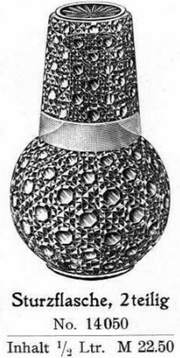Owned and Curated by Glen and Stephen Thistlewood
|
Regal Cane (OMN Hammonia) - Brockwitz
|
Regal Cane was originally named Hammonia by Brockwitz.
This rare tumbler, currently only known in marigold, stands approx. 3.5 inches high. Bob adds further detailed information: “there are16 panels of the cane pattern. Eight panels have three circles and four knobbed squares between them. The other eight panels have four circles and three knobbed squares between them. The panels are alternated giving it the cane like appearance. The base of the tumbler is 1.75 inches wide and has a sixteen point star on it. The Regal Cane tumbler was made using a four piece mould.” Regal Cane (Hammonia) is one of Brockwitz’ earliest patterns and is shown in their 1915 catalogue in which iridised glass is featured. It’s entirely possible, that the tumbler was made several years before that. Here’s a piece written by Bob about the Brockwitz factory and its legacy. “Every day many cars drive into an ordinary parking lot in Coswig, Germany; park for awhile, do what they have to do and then drive off the lot. Unbeknownst to the drivers is the fact that the generation before them worked on that very spot producing some of the finest Carnival Glass ever made. This lot was the spot where Brockwitz Glasfabrik AG, better known to us as just plain Brockwitz, made their wonderful glass. This was the place where the little gem of a tumbler named the Regal Cane was born.” |
The Regal Cane tumbler was shown in Brockwitz 1915 catalogue as a stand-alone item. It is also paired with a bottle/flask ("flasche") as a tumble up, and as part of a 4-piece water set (pitcher, two tumblers and a tray). The Regal Cane range featured in Brockwitz catalogues through to the late 1920s.
The Regal Cane tumbler was shown in Brockwitz 1915 catalogue as a stand-alone item. It is also paired with a bottle/flask ("flasche") as a tumble up, and as part of a 4-piece water set (pitcher, two tumblers and a tray). The Regal Cane range featured in Brockwitz catalogues through to the late 1920s.
Catalogue images courtesy of Dieter Neumann and Siegmar Geiselberger.
Visit the Classic Worldwide Tumbler Room
Visit the Classic Worldwide Tumbler Room




